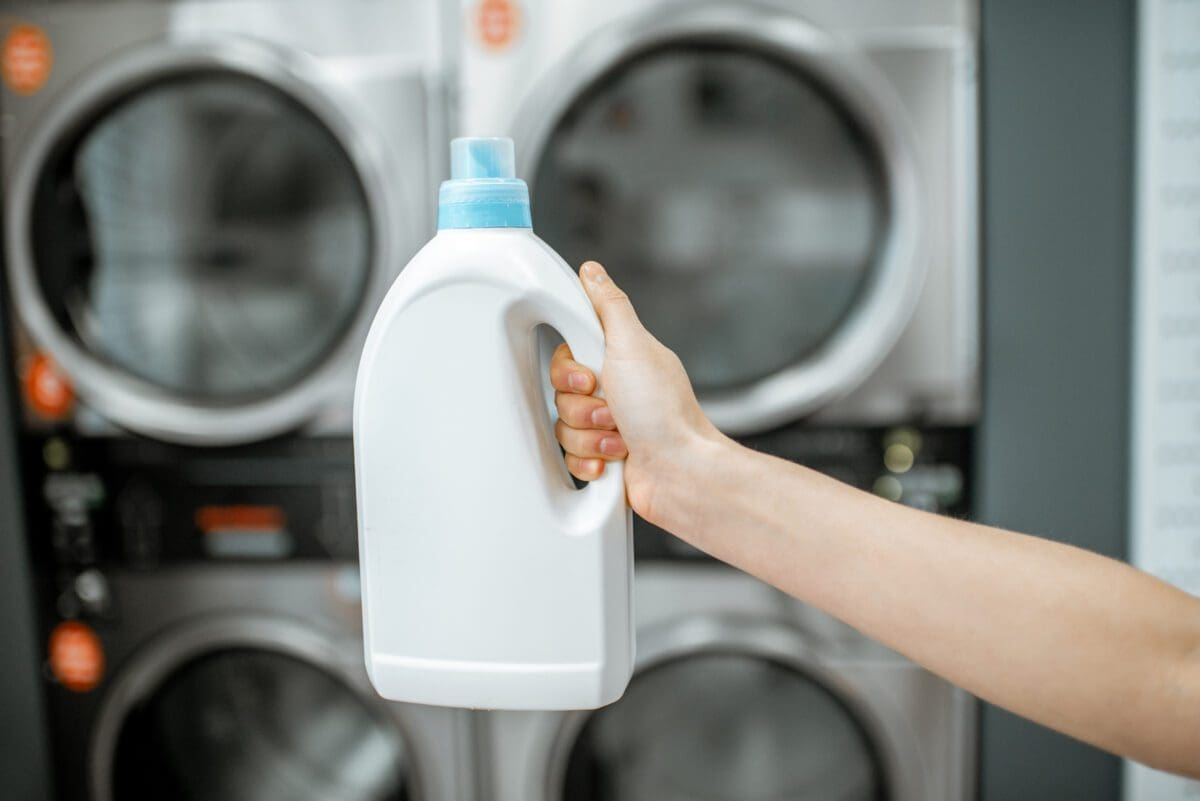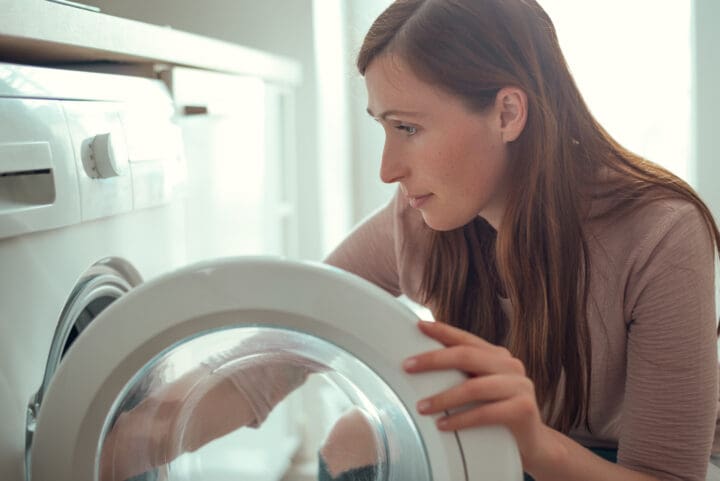Discovering a bed bug infestation in your home can be a moment of sheer panic. These pesky pests, not much larger than an apple seed, are notorious for their resilience and the discomfort they bring.
Now, imagine finding out that your washing machine might be their new hiding spot. If this happens, you will inevitably be asking yourself, how do I clean my washing machine after bed bugs?
Well, in this guide, we’ll walk you through the steps to ensure your washing machine and clothes are free from these unwanted guests.
By understanding the infestation and taking swift, effective action, you can ensure your washing machine and clean clothing remain clean and bug-free!

Before diving into the cleaning process, you must first recognize and confirm that you’re dealing with a bed bug infestation. These little intruders have specific signs and patterns of behavior that can help you identify their presence.
Bed bugs are often mistaken for other household pests due to their minute size, like fleas. However, when fully grown, adult bed bugs resemble an apple seed in both size and reddish-brown color.
Their bodies are flattened and oval-shaped, and they can appear slightly swollen and redder after feeding on blood. Observing these insects directly is a surefire indication of an infestation.
Despite their stealthy nature, bed bugs leave behind evidence of their existence. Dark spots on bed frames, box springs, or linens can be a telltale sign.
These spots, which are the excrement of the bugs, often give away their hiding spots. Another indication is a sweet, musty odor that might permeate the room, resulting from pheromones produced by large groups of bed bugs.
Bed bugs are cunning hitchhikers. If there’s an infestation in one part of your home, inspect all areas, especially your wardrobe and laundry.
They can easily ride on clothing from an infested area, and if those clothes with bed bugs are introduced to the washing machine without pre-treatment, the washer becomes a potential new residence for these pests.
Before tackling your washing machine and its problems, ensuring your clothes are bug-free is crucial.
This is because no matter how well you clean the machine, reinfestation can occur if the clothes remain contaminated. So, here’s a step-by-step guide to assist you:
Before handling infested garments, it’s wise to wear gloves, ensuring any bugs don’t transfer onto you.
Then, lay out your clothes on a flat surface, preferably outdoors or in a well-ventilated area, to inspect and prep them.
Using a spray bottle filled with rubbing alcohol, mist your clothes evenly. Rubbing alcohol not only helps to kill some of the bed bugs on contact but also acts as a disinfectant.
Remember to spot-test on a small, inconspicuous area first to ensure it doesn’t damage or discolor the fabric.
If the material reacts adversely to the rubbing alcohol, consider diluting it with water or seeking an alternative treatment method. It’s always essential to prioritize the integrity of your garments.
Once sprayed, immediately place the clothes into trash bags, sealing them tightly. This action ensures bugs and their eggs are contained, preventing further spread.
Don’t be afraid to double-bag, as it can offer an added layer of protection and peace of mind.
Always check the washing instructions on your clothes to prevent damage. Wash your clothes on the hot water cycle for the most effective bug eradication.
Use the hottest temperature the fabric can handle, as this heat will kill both adult bed bugs and their eggs.

Pour in a regular detergent, ensuring you use the recommended amount.
The mixture of water with detergent, especially in hot conditions, breaks down the protective layers of bed bugs, making them vulnerable to the hot water temperature.
A quick wash might leave some bugs behind. By selecting a prolonged washing cycle, you ensure the clothes have extended contact with bed bugs-killing elements: hot water and detergent!
After washing, transfer the clothes to the dryer and set it on the highest heat the clothes can tolerate. A prolonged heat cycle is another assurance that no bug survives.
For those items that can’t be dried, consider air drying in direct sunlight, as the sun’s UV rays can also aid in killing bugs.
Once your clothes are clean and dry, store them in airtight bags until you’re certain the infestation in your home is completely eradicated.
This step is a preventative measure to keep your clean clothes safe from any bugs that might still be lurking.
Once you’ve taken care of your clothes, attention must shift to the washing machine. After all, the last thing you want is to reintroduce clean clothes to a machine that’s still infested.
It’s a tricky question, how do I clean my washing machine after bed bugs? So, here’s a step-by-step guide to help you cleanse your machine thoroughly:
Before starting the cleaning process, ensure that the washing machine is completely empty. This means removing any residual water, lint, or stray clothing that may have been overlooked.
Checking all nooks and crannies, like the rubber gasket on front-load washers, is essential.
Using a vacuum cleaner with a hose attachment, thoroughly vacuum the interior drum and every accessible part of the washer.
This can help in removing bugs, eggs, and any debris. After you’re done, make sure to immediately empty the vacuum cleaner outside, away from your home, to prevent any potential spread.
Mix a strong detergent with water, ensuring it’s in a higher concentration than what you’d use for a regular wash.
Wearing gloves, take a scrubbing brush and scrub the machine’s interior thoroughly. Make sure to get into all the corners and around the agitator if your machine has one.
Once scrubbed, set your washing machine to run on the hottest temperature setting without any clothes. Add some regular laundry detergent to the water in the detergent compartment.
This hot water cycle acts as a double assurance, guaranteeing the elimination of any remaining bugs on contact.
Bugs and their eggs can sometimes hide in the most unexpected places. Remove the dispensers if they’re detachable and wash them in hot water.
Use a cloth soaked in hot water and detergent for non-removable ones to clean them thoroughly.
The exterior and surrounding areas of your washing machine shouldn’t be neglected.
Wipe down the outside of the machine, and inspect the floor beneath and the wall behind for any signs of bugs. Vacuum these areas if necessary.

To prevent future bedbug infestations in your machine, always check clothes for signs of bugs before washing.
As an added preventative measure, consider running a bi-weekly hot water cycle with vinegar or a washing machine cleaner.
Keep the following tips in mind before you start cleaning the washer:
Maintaining a bug-free environment in your home requires more than just a one-off cleaning spree. Persistent pests like bed bugs need consistent monitoring and prevention methods to ensure they don’t return.
First and foremost, make it a routine to inspect your bed frames and box springs. Dark spots or tiny droppings are often clear indicators of bed bug activity.
Apart from inspections, decluttering plays a pivotal role in bed bug prevention. These pesky pests love hiding spots, so seal off any potential nesting areas, particularly in bedrooms.
As for your garments, exercise caution. Bed bugs can easily hitch a ride on clothing, so it’s best to avoid placing them directly on bed frames or box springs.
Regularly inspecting each garment before washing can further reduce the chances of an infestation.
Additionally, to ensure your washing machine remains free of any potential bed bug remnants, consider doing a bi-weekly deep cleanse using the machine’s hottest cycles.
Hopefully, you’re no longer wondering: how do I clean my washing machine after bed bugs? Facing such infestations can feel overwhelming, yet the solution is more straightforward than one might imagine.
Utilizing the power of hot water during your washing cycles, paired with the cleaning strength of regular detergent, is a surefire way to clean your garments and machine.
Yet, cleanliness alone isn’t the answer. Remember, proactive measures like inspecting bed frames and adhering to washing instructions significantly reduce the risk of these pesky pests returning.
Stay informed, take action, and enjoy the peace of mind of a clean, bed-bug-free home!